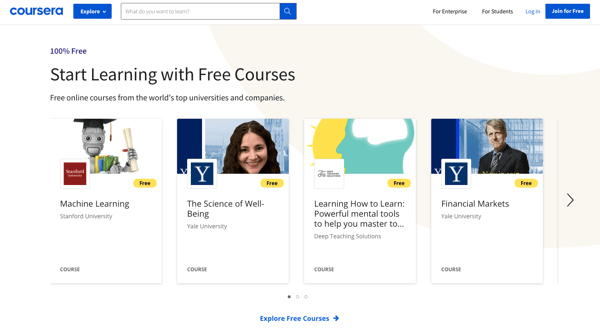In the words of Jack Welsh, ex-chairman and CEO of General Electric, “An organization’s ability to learn, and translate that learning into action rapidly is the ultimate competitive advantage”.
Training is the process by which human abilities and behaviors are developed, their strengths are enhanced, and the overall capabilities of employees are improved. The process of learning and training molds the rational thinking of an employee, leading to enhanced performance.
It's no news that organizations train their people, and even invest huge amounts of time and money doing so. Yet often, the business value which companies get from training their employees is unknown. Because everyone has different ways of learning, effective training requires a customized learning style, which traditional learning methods lack.
In this digitalizing world, how can organizations adapt their training in order to effectively coach their employees? How is the growing trend in e-learning and AI transforming the way we can cater to each learning style?
What's in this post?
- Workplace Diversity Includes Style Diversity
- Importance of Understanding Varied Learning Styles
- Limitations of Traditional Learning Styles and E-learning Platforms
- Using Artificial Intelligence to Effectively Train Different Learning Styles
Workplace Diversity Includes Learning Style
A lot of attention has already been drawn to the importance of hiring a diverse workforce. Diverse ethnic representations points to diversity in other areas: gender, sexuality, religion, neurology, physical ability, etc. In fact, the latest studies by McKinsey revealed that companies in the top quartile for diversity are more likely to have financial returns above their national industry medians.
Sure, this correlation is not necessarily causation - having a diverse ethnic workforce doesn’t automatically translate to more profit. However, it definitely does suggest that when workplaces work towards creating a diverse workplace, customer orientation is often improved, and employee satisfaction is higher, which all lead to increased returns.
As diversity is brought to the forefront of attention for many managers, organizations are realizing the importance of understanding how each employee is a nuanced blend of identities, and how this, in turn, affects their learning process.
Importance of Understanding Varied Learning Styles
It’s no news that learning styles vary widely - in fact, the way learning is perceived has been influenced heavily after the idea of different learning styles started to gain popularity in the mid-70s.
Individuals often have different approaches to the same problem, and the teaching styles have a substantial influence on the development of learning solutions. As a matter of fact, multiple factors can be identified which may impact this development process, including ethnicity, age, gender, and cultural background.
A University of Georgia study that researched whether or not learning styles were related to gender and age found that "males scored significantly higher on the Abstract Sequential channel than females, and women scored significantly higher on the Abstract Random channel than males”, which highlights the idea that different genders would indeed benefit from different learning styles. With that being said, it is clear that there is no one-size-fits-all training program for coaching or a flawless educational model that will have the same effect on everyone.
Limitations to Traditional Learning Styles
Many of us already have first-hand experience with traditional learning styles. Sitting in a classroom listening to a teacher explain a concept for an hour isn't - many of us can probably agree that a lot of the information wasn't retained and it wasn't the most engaging way to learn.
Teaching methods like lecturing are passive and can cause those learning to disengage easily as the information which has to be absorbed is isolated from its context, furthermore, there is no mechanism to ensure that people are intellectually engaged with the material.
Limitations to E-learning Platforms
E-learning platforms have also been met with a lot of skepticism, despite their rapid growth. As the Covid-19 shutdowns forced us to transition to online models, the masses had to rapidly adapt to new ways of interacting, working, and recruiting as the pandemic hit its peak. As a result, massive trends in the area of e-learning platforms and on-demand coaching began, and traditional courses moved online.
Take for instance Coursera Inc., an online course provider which works with universities to provide online courses, certifications, and degrees for people around the globe.

Lynda is another platform, which is one of the leading platforms currently in remote learning, providing hundreds and thousands of online training courses, varying from managerial skills to creative skills in multiple languages. In fact, LinkedIn’s acquisition of Lynda is proof of the growing demand in e-learning platforms, and the revolution in talent management that is happening right now.
The remote nature of such platforms like Lynda and Coursera Inc., makes it an attractive way for employees to up-skill easily.
However, these e-learning platforms are not without limitations. They typically measure variables such as the number of modules that have been completed, or access times, but not factors that reflect actual behavioral changes. The platforms provide plentiful knowledge and content, but the lack of interactivity means that they do not have the ability to shape behavior, communication, or interpersonal skills.
Traditional learning styles or e-learning platforms are often lacking adaptivity and interactivity. As they offer the same resources for all users, irrespective of their individual needs and preferences, not every learning style is accounted for. As companies are realizing the necessity of interactivity to produce meaningful results within learning and training, teams around the world are beginning to address this issue through AI.
Using AI to Effectively Train Different Learning Styles
Artificial intelligence is gaining traction due to its adaptive style. Dom Barnard, co-founder of a VR training platform Virtual Speech, highlighted the importance of personalizing teaching styles between males and females, and how artificial intelligence can be employed to help improve a learner's weaker areas. By predicting suitable content based on the algorithms, Virtual Speech’s VR training allows users to have realistic ways of practicing various soft skills and receive instant feedback.

Retorio is another company in the emerging scene of AI today. Retorio combines video analysis with client simulations to offer interactive training solutions for customer-facing positions, such as sales, consulting, etc. Their clients use Retorio to scale up their training programs, as well as coach their sales teams. Retorio’s AI analyses staff, and provides insight to employers about what makes their employees tick - and unveils what the most pressing talent needs.

Achieving diversity is no easy task for workplaces to accomplish, especially when it comes to catering to various training styles. Thankfully, artificial intelligence platforms such as Retorio are paving the way to customizable coaching and are normalizing AI as a tool for corporate training.
As the AI industry develops, there is an increasing likelihood that more and more companies will leverage the benefits of AI to customize their training in order to effectively cater to each learning style.
If you'd like to see how Retorio can help employees upskill and gain insight into their strengths and weaknesses, you can try out the AI for yourself below.



